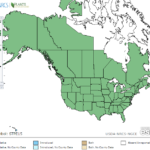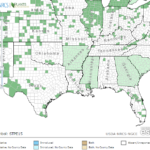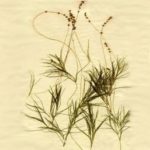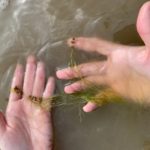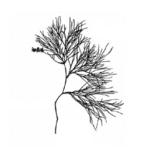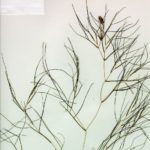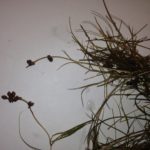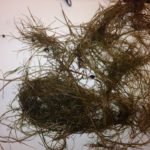Stuckenia pectinata
USDA, NRCS. 2018. The PLANTS Database (http://plants.usda.gov, 28 March 2018). National Plant Data Team, Greensboro, NC 27401-4901 USA.
Illustration courtesy of University of Florida/IFAS Center for Aquatic and Invasive Plants. Used with permission.
What is Sago Pondweed?
Other common spellings and names include: sago-pondweed, fennel pondweed, fennel-leaf pondweed, comb pondweed, ribbon weed, and sago false pondweed.
Physical Characteristics
Leaves:
- All submersed
- Alternate
- Thinly linear or threadlike
- Up to 6 inches long and 0.05 inches wide
- Strong cross veins
Small Leaves:
- 0.078-2 inches long
- At the base of normal leaf
- Greenish or whitish
Flowers:
- 4 petals and sepals
- Nearly immobile
- Greenish in color
- Oval- to elliptical- shaped
- 0.05-0.09 inches wide
Fruit:
- Fleshy
- Narrow base
- Rounded on top side
- 0.09-0.16 inches long
- 0.08-0.13 inches wide
Stem:
- Horizontal stem branching
- Slightly compressed
- Light green to almost white
- About 0.05 inches in diameter
- Simple near base
- Abundantly branched near top
Where Does it Grow?
Sago pondweed can be found in alkaline, brackish, or saline water of ponds, quiet rivers, lakes, marshes, and ocean shores. They often occur in great masses.
Pros and Cons of Sago Pondweed
Sago pondweed is an excellent food for waterfowl, especially canvas backs, which eat both the fruits and the tubers. Submerged portions of all aquatic plants provide habitats for many micro and macro invertebrates. These invertebrates in turn are used as food by fish and other wildlife species (e.g. amphibians, reptiles, ducks, etc.). After aquatic plants die, their decomposition by bacteria and fungi provides food (called “detritus”) for many aquatic invertebrates.
